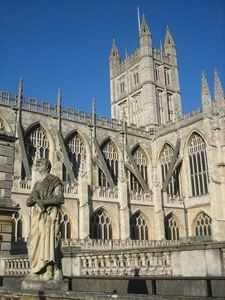Advertisement
Published: November 2nd 2007

 The Abbey and Roman Statue
The Abbey and Roman Statue
The Statue is actually a Victorian knock-off, created when they re-discovered the Great Bath and built the terraces I'm standing on here around it.I've wanted to visit Bath ever since I can remember - the first time I heard of there being such a place is lost in the mists of time. I seem just always to have known of its existence. I was so anxious to be there that I hot-footed it to the Exeter bus station and was early for my bus. The chattering bus driver made the journey from Devon to Somerset a little different - he suffered from delusions of grandeur, announcing everything as though he was an airline pilot, hence: "Bing bong, this is your captain speaking. Welcome on board National Express flight 324 to Bristol. We will be cruising at an altitude of roughly 12 feet.... bong bing." Similar announcements punctuated the journey, and unlike most of the National Express drivers, he pointed out several spots of interest along the way.
I didn't want to wait several hours in Bristol for the NX connection down the road to Bath, so I grabbed a local bus and climbed out next to an enormous pile of earthworks half an hour later. Bath is currently undergoing a city centre restructure which will see a state of the art retail centre
built above brand new train and bus stations. At the moment it's all just a big hole in the ground, and due to Bath's archaeological heritage there's a dig going on in the middle of the construction site. Since the city was built on top of Roman ruins in an area already significant in early English history, important artifacts are found and discoveries made every year, and the ongoing piecing together of history is part of the fascination of a visit to the city.
First stop for me was the centre of town - the Roman Baths. The admission fee is a bit steep, and I saw several people turn away because of it, but I decided that I couldn't come this far and stop for the sake of a couple of pounds extra. The Baths are the oldest surviving structure in town, fitting since they gave the city its name. There is a little illusion - the buildings and terrace surrounding the actual baths were all built by the Victorians, who rediscovered and restored the original Roman bath, which had lain buried under centuries of crumbling stones from later inferior bath houses built on top of the Romans'

 Pulteney Bridge
Pulteney Bridge
Just above the Weir.masterpiece. The floor level is all original Roman, though, and excavations extending under the streets all around the bathhouse precinct have uncovered anterooms and the courtyard and steps of a great temple. The Romans believed in the spiritual as well as the physical benefit of the waters, and worshipped the godess Minerva Sulis here.
I found the baths, plunge pools, hypocausts and temple remains fascinating, and was surprised to be told to leave when the baths closed at six. I'd been completely unaware of the time, and managed to spend over two hours without getting even halfway round the tour. Luckily, on the basis that I'd had no warning of the imminent closure, so hadn't been able to race through the rest of the exhibits, I managed to negotiate re-entry for the next day. I returned at luchtime to pick up where I'd left off, admiring the underfloor heating and the plumbing - the original lead pipes are still in place in many of the inlets and drains, and still direct the steady flow of water through the baths, with the wastewater flowing out into the river a couple of blocks away. By my guess, using poisonous lead in

 Listening to Bill
Listening to Bill
The audio guide is extremely good, covering most of the rooms and their functions, as well as detailing methods of excavation. Bill Bryson provides a commentary as well - mainly rapturous rambling about how awesome the baths are!their buildings, implements and decorations was about the only thing the Romans got wrong. I wonder if conspiracy theorists have traced use of lead to the downfall of the Roman Empire?
Before my re-entry to the Roman Baths, I took one of the excellent free walking tours run by the Mayor's Office. Forty or so voluntary guides each take a couple of these tours a week, and I can't reccomend them highly enough. Over the course of two hours our knowlegeable guide Malcolm lead us around the town centre, covering the Baths in all their incarnations, the building of the central church - known as the Abbey, even though this building has never housed a religious order. (An earlier church did.) We went past the Royal Infirmary, which was the first free hospital in Britain, and is now a specialist centre for rheumantic diseases. We finished the tour past the Circus and the Upper Assembly Rooms, in the park in front of the landmark Royal Crescent.
Before he wrapped up, Malcolm told us a little about the building and preservation laws in Bath: buildings must always be built of the traditional Bath Stone, a pale limestone quarried locally,

 The Great Bath
The Great Bath
Looking down from the terrace. The water has a greenish tinge because the algae in it love the sunlight. Back in Roman times the Bath was not open air, but covered with an enormous vaulted roof.and planning permission in any of the older homes must be sought before any alteration. This even includes indoor remodelling which the public won't see. Notifications of building plans are pinned to fences all around town for residents to read, and the rigorous regulations mean that even applications for window frames, new shower units or mezzanine floors must be submitted publicly.
These strict rules have spawned a few debates, but I'm sure none of them are funnier than the story of the Yellow Door. One day, the female owner of number 22 Royal Crescent had her front door painted yellow. As a Bath icon, the Georgian terrace of thirty houses is listed as a Grade One Heritage Building, and there was an outcry over the yellow door. Colours are absolutely verboten in the area, where all the doors and windows are either natural wood or painted a demure white. The council was brought in, and ordered her to restore the door to a legal colour. When she refused, the case went all the way to the Supreme Court! Rumour has it the owner is a great-great-however-many-greats-grandaughter of the Duke of Wellington, so perhaps you'll not be astonished to hear

 Where the Romans trod, so do I
Where the Romans trod, so do I
Me, the Abbey and the Great Bath.that she won the battle. Not only is the door yellow to this day, but it is now in the deeds of the house that it must remain so - no future owner will be able to restore it to traditional white or brown!
We were well over our allotted two hour tour time, but Malcolm led some of us back down the hill to the Pump Room, via the gravel walk Anne and Captain Wentworth walked, and past Nicolas Cage's back garden. (Yup, the American actor has a house in Bath. Who knew? Apparently he is sometimes spotted in the garden.) Set loose again, I finished up my visit to the Roman Baths and took the waters in the Pump Room. Not only were the Georgians of fashionable Bath supposed to bathe in the waters, they were prescribed draughts of it as well - sometimes being advised to drink as much as 2 litres a day of the stuff. To make the experience more tolerable, the Pump Room was built, and the ladies and gentlemen could collect their dose from the King's Pump and sip it while conversing politely or listening to the orchestra. Readers of Jane Austen

 Caecilius lives?
Caecilius lives?
Costumed guides ran free tours every couple of hours, and were a huge hit with the children.will know that the Pump Room was
the place to be seen in the mornings.
Members of the tour group who had already tried the water advised those of us who hadn't that it was a once in a life time experience - that is, something no sane person would attempt twice - so I was steeled for a foul taste when I collected my glass from the Pump Attendant. In fact, it's not that bad - kind of like an unsweetened and less lemony L&P. Which is of course exactly what it is. (For those of you not in the loop, L&P is
Lemon & Paeroa, the soft drink that's "World Famous in New Zealand." It's made with water from the natural spring in Paeroa, NZ.)
I found a copy of
Emma in the hostel bookshelf, and it was my bedtime reading while I was in town. As you may have been able to guess, I am a big fan of Jane Austen's novels, which I think are some of the finest books ever written in english. Jane spent several years living in Bath, a very fashionable place at the time, until the death of her father made it

 The Great Pediment
The Great Pediment
Part of the temple frontage, featuring incrediable carving, as well as proof (in the lower right hand corner) that the Romans knew the earth was round.too expensive for the family to stay. While it doesn't seem she liked the place much, and there's no evidence that she actually wrote anything while she lived there, it certainly made a huge impression on her. Her descriptions of society and fashionable behaviour and her keenly drawn pictures of human nature must have been drawn from her observations of Bath society. Characters (often the morally questionable characters!) in her books are sent to Bath, and she set one entire novel -
Persuasion - in the city. Being in Bath and reading Mrs Elton's snooty remarks and comparisons of Highbury to Bath, was a very special part of my visit.
I finished my time in Bath with a moonlit swim in the modern Thermae Bath Spa. A hugely expensive place to visit, they charge £20 for only two hours in the pool complex, and I wavered over the expense for some time - but as I bathed in the outdoor rooftop pool, floating in the warm waters the Romans had first trapped over one and a half thousand years previously, and admiring the floodlit city, it was worth it.
Advertisement
Tot: 0.167s; Tpl: 0.014s; cc: 15; qc: 64; dbt: 0.0959s; 1; m:domysql w:travelblog (10.17.0.13); sld: 1;
; mem: 1.2mb



















